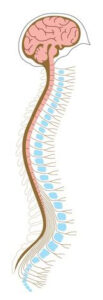 If there was a magic pill to eliminate pain forever, we would all take it. Until that day, there are simple strategies you can use to help manage your chronic pain. Simple, such as finding daily movement strategies that lessen your pain and enable you to keep doing what matters most.
If there was a magic pill to eliminate pain forever, we would all take it. Until that day, there are simple strategies you can use to help manage your chronic pain. Simple, such as finding daily movement strategies that lessen your pain and enable you to keep doing what matters most.
It’s the little things that cause the biggest changes, and improper movements done consistently throughout a lifetime can lead to pain and dysfunction. Did anyone ever show you how to sit and stand without causing back pain? I’m sure someone did tell you to sit up in your chair and avoid slumping. It’s not hard to get great results with a chiropractor addressing your spinal pain and dysfunction, but you can also assist your doctor in helping you get better by making small changes in how you do certain things.
Of course, none of us are perfect; this is a slow—yet effective—process. Below are a few key movement strategies that can be performed every day as part of your daily routine, helping over time to lessen chronic pain and make you feel better.
Stop Slumping
One of the hardest things to do is to correct our posture. There are various degrees of what people believe is “good” posture, but simply put, “good” posture is consistent, pain-free movements. Many people sit at work and school, slumped down in their chairs, leaning forward and looking down at their phones. Most of us have figured out that this normally causes spine pain as well as arm and leg pain. No one sits up perfectly straight all the time, but being mindful of it helps. There are options such as apps, smart wearables, and post-it notes that can help by giving you little reminders. Students, desk workers and truck drivers owe it to their neck, back and shoulders to try to sit up more.
Sitting Down and Standing Up
Most people lean forward and/or bow when standing or sitting. When your body is leaned forward while you’re about to stand (think past 90 degrees), your lower back experiences nearly double the pressure it normally would.1 Sitting in the sitting position while leaning forward repeatedly can cause wear and tear on spinal muscles and supporting connective tissue. Instead, try to maintain a forward gaze as you sit down and stand up. Eye movement controls head movement, which in turn controls body movement. To take pressure off the spine when sitting, back up to the chair or bench until your lower legs are touching it, and then think of pushing your hips straight back and down (see You Tube: hip hinge) while sitting down. Feel free to use your arms and the chair to assist you as you get used to this position. It is also important that you try not to plop down, as this can hurt the spine. Performing the same movement in reverse will help you stand with less pain. This normally requires more training since the pattern of leaning forward while standing is hard to quit. This effort can be helped by sitting forward in the chair and using your upper body strength to push up while looking forward, not down. For standing without chair arms, put your hands or fists in the crease between the hips and torso while holding pressure there as you rise. Once this is implemented into a daily routine, spinal stress will lessen and injured tissue can heal.
Walking
Walking is a basic human function, and most people don’t walk enough. You’ve probably been told by a healthcare provider that you should walk for your cardiovascular system, but it’s also a great way to lessen spinal pain for most people.2 Without poking your chest out, imagine yourself walking tall. While in school or at the doctor’s office, we stand as tall as possible when our height is being measured, and we should think of the same when walking. As stated above, constantly leaning forward causes spinal stress, so if you sit slumped down in the chair, you more than likely slump down when walking and picking up items, too.
Carries
When picking things up, walking with a weight in one or both hands is a great balance, grip strength and cardiovascular workout. Starting off with one hand (see YouTube: suitcase carry) and the two-hand carry (see YouTube: farmer’s carry) will set you on the path to a stronger body, which can help support and strengthen a painful spine. As with walking, remember to do this while looking forward and not slumping down. With a half-gallon of water weighing around four pounds, and a gallon weighing around eight pounds, you can start doing carries today without any extra equipment.
Daily, consistent pain-free movement can be achieved for people who patiently practice. If the goal of the person in pain is to move well and hurt less, the solution starts within!
References
- The sitting posture: an electromyographic and discometric The Orthopedic Clinics of North America, 01 Jan 1975, 6(1):105-120. Nachemson AL , Elfström G
- Lumbar Posture—Should It, and Can It, Be Modified? A Study of Passive Tissue Stiffness and Lumbar Position During Activities of Daily Living. Physical Therapy . Volume 83 . Number 10 . October 2003 Joan P Scannell, Stuart M McGill
Schedule an Appointment - We are here to help you!
Overland Park, KS Clinic
6701 W. 121st Street | Suite 200
Overland Park, KS 66209
913-643-1771
913-643-1775
Olathe, KS Clinic
10454 S. Ridgeview Rd.
Olathe, KS 66061
913-689-2333
913-689-2334
Prairie Village, KS Clinic
4121 W. 83rd St. | Suite 147
Prairie Village, KS 66208
913-490-4444
913-490-4445
Raytown, MO Clinic
10803 E State Rte 350 | Suite B
Raytown MO 64138
816-356-9313
816-425-2117
Lee's Summit, MO Clinic
338 Southwest Main St.
Lee's Summit, MO 64063
816-600-5483
816-524-5328
Belton/Raymore, MO Clinic
17027 Bel-Ray Blvd.
Belton, MO 64012
816-425-7015
816-425-2117
Blue Springs, MO Clinic
622 SW US 40 Hwy
Blue Springs, MO 64014
816-815-7007
816-815-7008
Liberty, MO Clinic
1520 N. Church Rd | Suite C
Liberty, MO 64068
816-831-3600
816-831-3601






